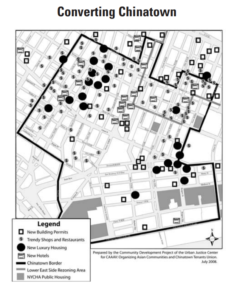To help New York City’s economy, an unregulated zoning plan was created in Chinatown to promote private development, which caused the residential gentrification of the neighborhood. Through the method of zoning, local governments have the power to influence the development of plots of land which will shape the community. After the events of 9/11, New York City needed to create changes to help revive the damaged economy. Ever since Mayor Bloomberg took office in 2002, his campaign implemented more than 100 rezoning plans for over 20% of the city’s land. Lower income neighborhoods such as Chinatown, have seen significant increases in upzoning, to allow for “pro-business economic development agenda” (Laskow). According to the Committee Against Anti-Asian Violence (CAAAV), to do this, the zoning plan allows for developers to create projects such as “luxury condominiums, boutique hotels, trendy restaurants, and expensive stores, altering the urban character” in order to attract tourists and wealthier residents. The introduction of these new developments will inevitably increase the property value of the neighborhood. While that may not seem like a problem, the mayor’s plan for rezoning outlines no protection of current residents against gentrification nor does it implement regulations on the amount of private developments that can be built. It is evident that the City’s economic development plan is to create communities that cater to wealthier individuals. This comes at the expense of lower income residents that have resided in rezoned neighborhoods for a long time. Thus, in order to boost the economy, the city created zoning policies to attract wealthier individuals that will displace its existing residents.



